American Electric Power’s goal: 100% renewable energy?
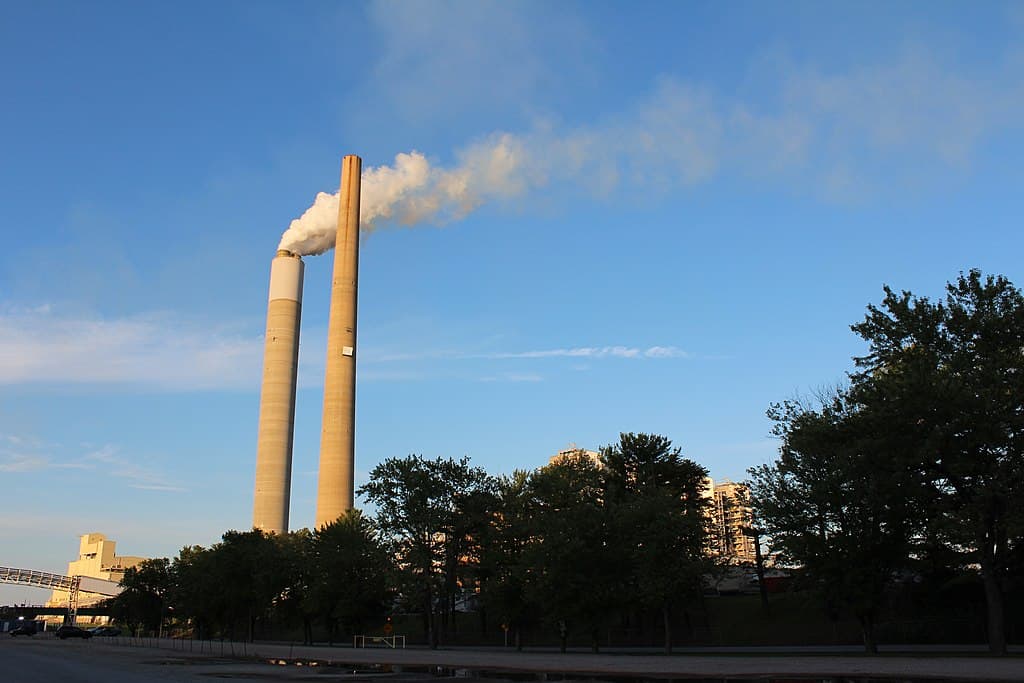
Executives at American Electric Power say the major electric utility has “aspirational” goals of achieving 100% renewable energy and zero carbon emissions, but its current plans for the future include a hefty dose of fossil fuels.
“So you know from the standpoint of AEP our aspiration, our goal is to reduce our carbon footprint by 80% from our 2005 emissions by 2050, with an aspiration for 100% renewables,” Lisa Barton, executive vice president of utilities at AEP, said in February at the annual Ohio Energy Management Conference in Columbus.
After the event, the Energy & Policy Institute reached out to AEP for confirmation of its previously unannounced 100% renewable energy aspirational goal, which was not included when the utility revealed new carbon reduction targets last year. Those targets included reducing carbon emissions to 70 percent below 2000 levels by 2030 and 80 percent by 2050, as well as an aspirational goal of zero carbon emissions.
“I believe she [Barton] was speaking in the context of our aspirational goal of zero emissions by 2050, which would essentially require 100 percent renewables,” said Melissa McHenry, director of external communications for AEP, in an email. “So, no it is not a new goal … she just expressed it a bit differently.”
Many utilities have set goals to decarbonize their electric generation, but no large ones that are currently reliant on fossil fuels, like AEP, have credibly said they would do so using only renewable energy. Most other utilities have set “net-zero” carbon goals, implying the use of carbon offsets, or “zero-carbon” goals, leaving the door open for the inclusion of nuclear energy or possibly carbon capture and sequestration (CCS). AEP recently left America’s Power, a coal industry group that lobbies for “clean coal” and CCS, and opposes renewable energy.
A study commissioned by AEP Ohio found that 86 percent of its residential customers want the utility to make greater use of renewable energy, and 77 percent are willing to pay more for it. A survey conducted on behalf of the Edison Electric Institute also found broad national support among utility customers for producing “100% of our electricity from renewable energy sources such as solar and wind” in the near future.
So how serious is AEP about 100% renewable energy?
AEP recently downsized its 2020-2030 plans for renewable energy, and increased projections for its future reliance on fossil fuels
Scientists say urgent action is needed over the next ten years to limit the future impacts of climate change, but by 2030 more than half of AEP’s generating capacity will still come from fossil fuels like coal and natural gas that emit carbon.
AEP’s projected generation additions for 2020-2030 currently include 4,149 MW of solar and 3,935 MW of wind power, according to an investor meeting presentation from last month:
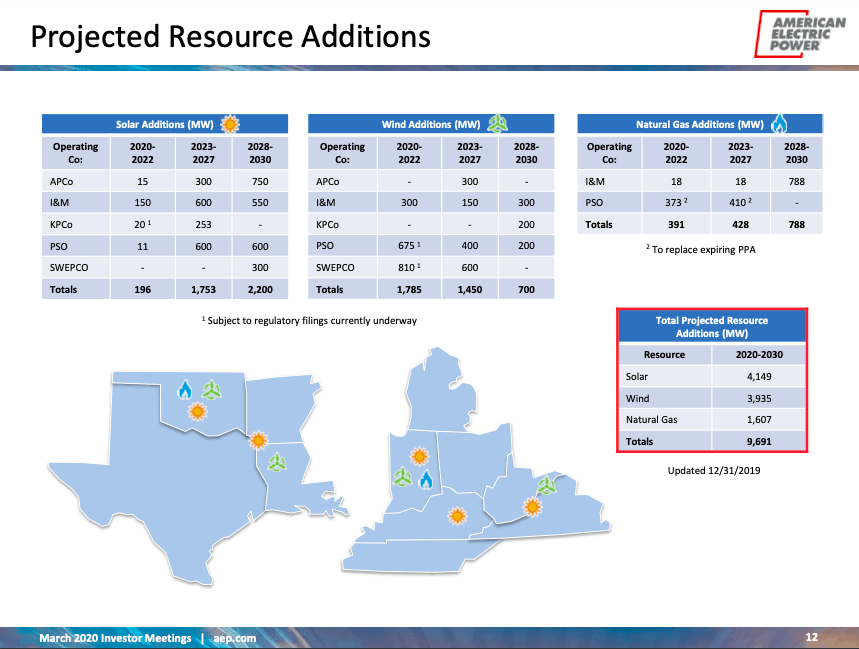
Those numbers for new renewables are down from earlier projections found on AEP’s sustainability website, where the utility predicted adding 4,366 MW of solar and 4,235 MW of wind power in 2020-2030:
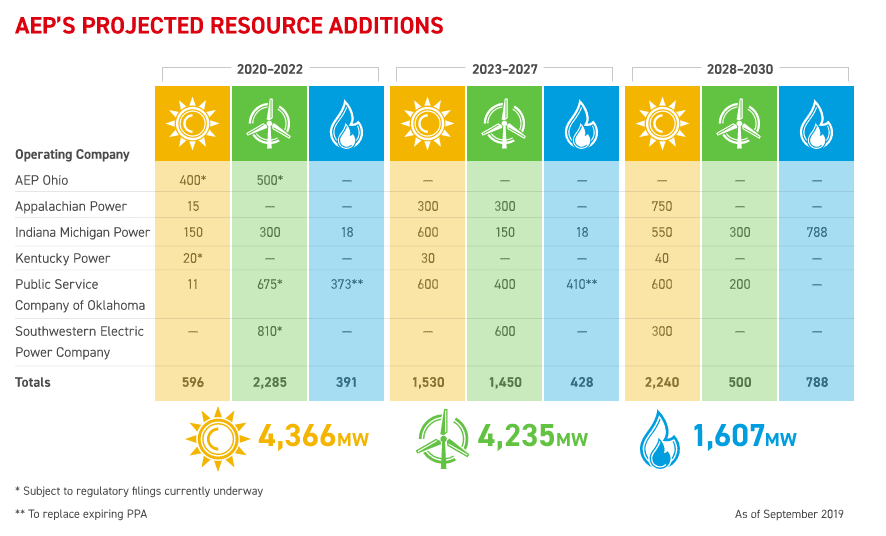
AEP projects adding 1,607 MW of natural gas, a fossil fuel, to its generation mix over the next ten years, with nearly half that new gas planned for 2028-2030.
For four AEP subsidiaries – AEP Ohio, Appalachian Power, Kentucky Power, and Southwestern Electric Power Company – new generation is projected to come entirely from renewables. Additions of new gas are predicted for just two AEP subsidiaries, Indiana Michigan Power and Public Service Company of Oklahoma.
AEP also recently increased its projections for coal as a portion of its future generating capacity through 2030 by one percentage point, while its projections for future natural gas capacity increased by three percentage points. AEP decreased its related projections for future solar, wind, hydro and pumped storage capacity by three percentage points, and energy efficiency/demand response by one percentage point.
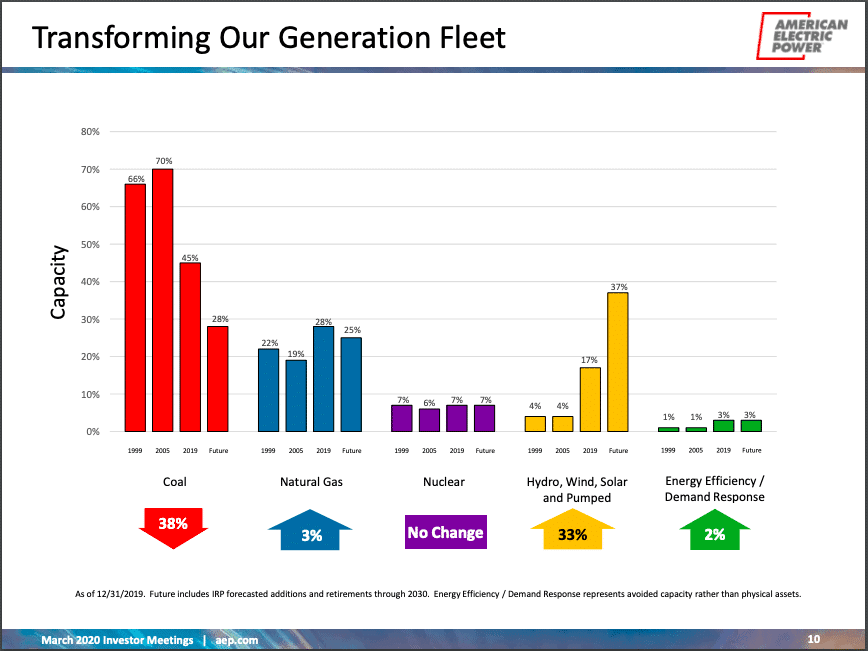
A chart from AEP’s investor meeting presentation in March
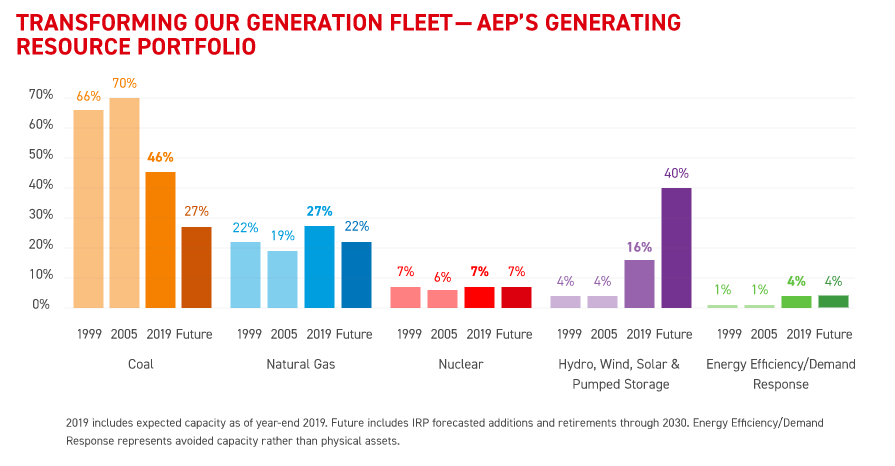
An earlier chart found on AEP’s sustainability website
AEP now expects that its future generating capacity through 2030 will be 28% coal and 25% natural gas. Only 37% will come from solar, wind, hydro and pumped storage, with the remainder coming from nuclear (7%) or being met through energy efficiency and demand response (3%).
The increased projections for fossil fuel generation fly in the face of a recent report from Morgan Stanley analysts, who found that AEP stood to gain the most in earnings of all investor-owned utilities from decarbonization, with an earnings accretion potential of 14% by 2025. Based on an asset-by-asset analysis, the report found that 94% of AEP’s 124 GW of regulated coal plants will be rendered uneconomic by 2024, primarily by lower-cost wind energy. As a result, the analysts increased their price target for AEP by $8 per share, or 8% at the time of the report.
At the conference in February, Barton also noted that BlackRock, a major investing firm, will no longer invest in companies that generate more than 25 percent of their revenue from coal:
And so you know regulators want to make sure that you as a company are appropriately managing your risks and, you know, ESG is coming up is as one of those risks, and now that we’ve seen so many folks like BlackRock, who is a major investor in utilities and a major investor in quite frankly probably most industries. What they say matters because we all use their money to be successful. We can’t provide the solutions that we provide if we don’t have investors behind it. And so if they say they don’t want to invest in companies that have 25% of their revenues coming from, you know, carbon emission facilities such as coal that’s something that needs to be taken to heart. And like all of you, you have to worry about your parent financing as well as your individual company financing so for for [sic] us as a company, we need to be sitting there and looking long term as we are, and what are we doing to lower our carbon footprint. Most importantly, how are we making sure that we’re managing that in a level that’s consistent with how our states want us to be managing those assets and what’s in the best interests of our customers.
AEP’s lobbying also shows a continued reluctance to fully transition off of coal. When Ohio passed House Bill 6 last year, AEP secured an extension of subsidies for two coal-fired power plants it co-owns through 2030. The new law also rolled back Ohio’s renewable energy and energy efficiency standards.
AEP on how to get to 100% renewable energy
Barton’s statement on 100% renewable energy came as part of a response to a question about carbon-neutral goals announced by energy companies.
Barton acknowledged that AEP doesn’t know how to get to 100% renewable energy, but she expressed optimism in technology and pointed to the growing ability to control customer demand for electricity as paving the way for an abundance of low cost renewable energy in the future.
Below is a transcript of the question, and Barton’s response:
Question:
Many corporations in the energy industry, including a few that are represented on the dais today, have announced their aspirations to be carbon-neutral by 2050.
What is driving these announced aspirations and, more importantly, how can these objectives be met while ensuring that Ohio consumers receive reliable energy at affordable prices?
Barton’s response:
So I think there’s a couple of key things that are resulting in this goal. Obviously, the first and foremost is, it seems to be what customers want. We hear more and more from our customers, and that they want to understand where their power is coming from, and they’d like to have a choice, they’d like to have a green choice. The other key fundamental is the fact that the cost of renewables has gone down dramatically over the past 10 years, and I will tell you, when Lazard first started providing their projections in terms of what the cost of renewables would be, I was a skeptic. I didn’t believe it could possibly go to the low levels that it’s gone to and it really has. At the same time, operators of the grid such as ourselves have recognized that we can actually integrate a heck of a lot more renewables than we ever thought possible within the grid itself. So, you know, from the standpoint of AEP our aspiration, our goal is to reduce our carbon footprint by 80% from our 2005 emissions by 2050, with an aspiration for 100% renewables. We’re recognizing in that aspiration, the fact that we don’t know quite frankly, how technically to get there. And I’m not sure that anybody in this country does at this point in time. But what they are counting on is technology. I think the folks that are saying that they want to go carbon neutral by 2050 are sitting down and saying over the next 30 years, there’s going to be significant changes in how energy is delivered, how it’s how load is controlled, and how generation is controlled. The most important thing to remember on you know, that integrated grid that we have is that generation equals load 24/7. In the past, and today, we control the generation. We dispatch generation, we control generation to meet our load requirements. Who knows what the future has in store, and it may be that we’re able to have an abundance of generation and an abundance of renewables low cost generation, and we’re instead controlling the load. I look forward to what the future brings.
Top photo of the Kyger Creek coal plant in Ohio by FunksBrother via Wikipedia Commons. This file is licensed under the Creative Commons Attribution-Share Alike 4.0 International license.



